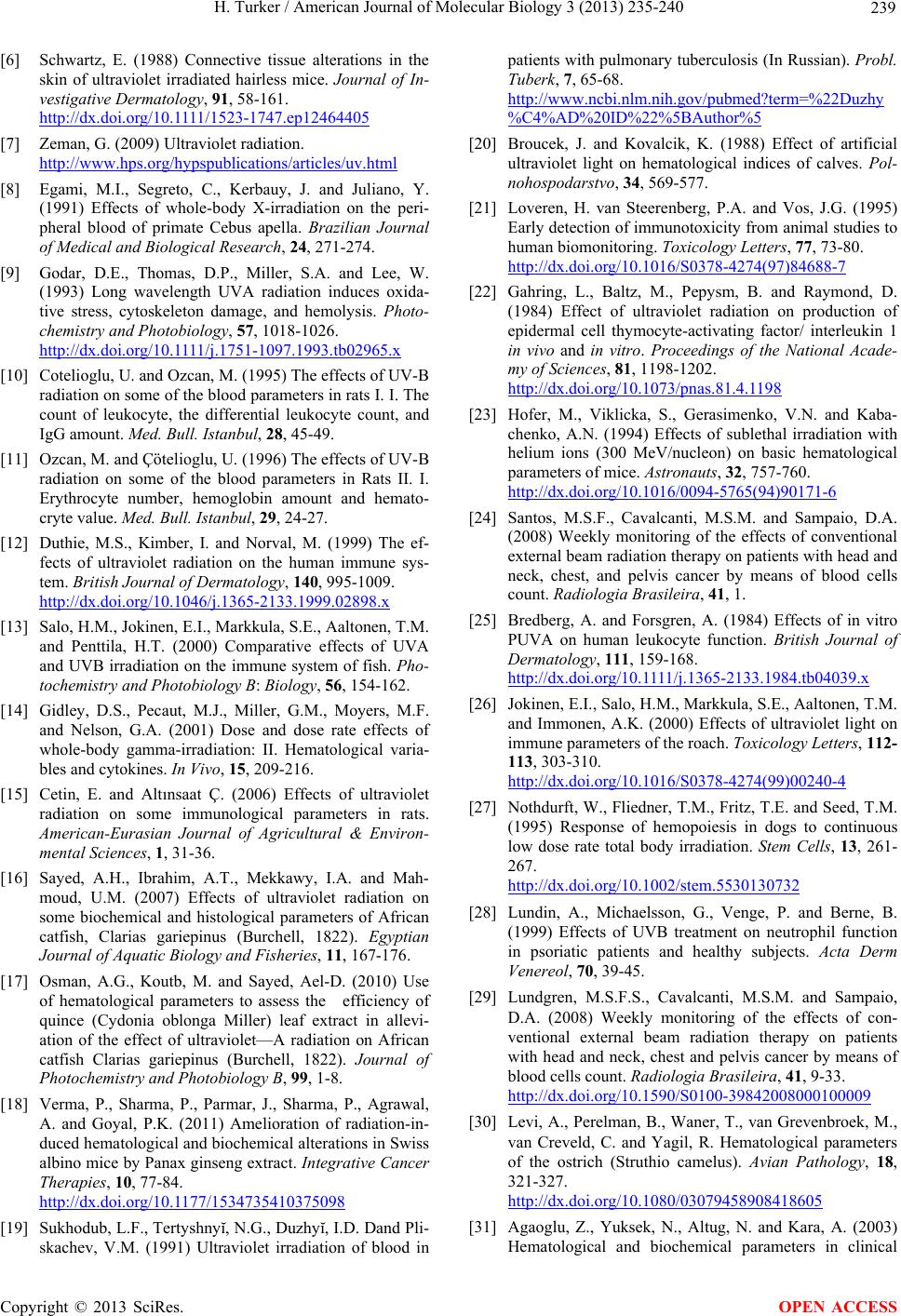
H. Turker / American Journal of Molecular Biology 3 (2013) 235-240 239
[6] Schwartz, E. (1988) Connective tissue alterations in the
skin of ultraviolet irradiated hairless mice. Journal of In-
vestigative Dermatology, 91, 58-161.
http://dx.doi.org/10.1111/1523-1747.ep12464405
[7] Zeman, G. (2009) Ultraviolet radiation.
http://www.hps.org/hypspublications/articles/uv.html
[8] Egami, M.I., Segreto, C., Kerbauy, J. and Juliano, Y.
(1991) Effects of whole-body X-irradiation on the peri-
pheral blood of primate Cebus apella. Brazilian Journal
of Medical and Biological Research, 24, 271-274.
[9] Godar, D.E., Thomas, D.P., Miller, S.A. and Lee, W.
(1993) Long wavelength UVA radiation induces oxida-
tive stress, cytoskeleton damage, and hemolysis. Photo-
chemistry and Photobiology, 57, 1018-1026.
http://dx.doi.org/10.1111/j.1751-1097.1993.tb02965.x
[10] Cotelioglu, U. and Ozcan, M. (1995) The effects of UV-B
radiation on some of the blood parameters in rats I. I. The
count of leukocyte, the differential leukocyte count, and
IgG amount. Med. Bull. Istanbul, 28, 45-49.
[11] Ozcan, M. and Çötelioglu, U. (1996) The effects of UV-B
radiation on some of the blood parameters in Rats II. I.
Erythrocyte number, hemoglobin amount and hemato-
cryte value. Med. Bull. Istanbul, 29, 24-27.
[12] Duthie, M.S., Kimber, I. and Norval, M. (1999) The ef-
fects of ultraviolet radiation on the human immune sys-
tem. British Journal of Dermatology, 140, 995-1009.
http://dx.doi.org/10.1046/j.1365-2133.1999.02898.x
[13] Salo, H.M., Jokinen, E.I., Markkula, S.E., Aaltonen, T.M.
and Penttila, H.T. (2000) Comparative effects of UVA
and UVB irradiation on the immune system of fish. Pho-
tochemistry and Photobiology B: Biology, 56, 154-162.
[14] Gidley, D.S., Pecaut, M.J., Miller, G.M., Moyers, M.F.
and Nelson, G.A. (2001) Dose and dose rate effects of
whole-body gamma-irradiation: II. Hematological varia-
bles and cytokines. In Vivo, 15, 209-216.
[15] Cetin, E. and Altınsaat Ç. (2006) Effects of ultraviolet
radiation on some immunological parameters in rats.
American-Eurasian Journal of Agricultural & Environ-
mental Sciences, 1, 31-36.
[16] Sayed, A.H., Ibrahim, A.T., Mekkawy, I.A. and Mah-
moud, U.M. (2007) Effects of ultraviolet radiation on
some biochemical and histological parameters of African
catfish, Clarias gariepinus (Burchell, 1822). Egyptian
Journal of Aquatic Biology and Fisheries, 11, 167-176.
[17] Osman, A.G., Koutb, M. and Sayed, Ael-D. (2010) Use
of hematological parameters to assess the efficiency of
quince (Cydonia oblonga Miller) leaf extract in allevi-
ation of the effect of ultraviolet—A radiation on African
catfish Clarias gariepinus (Burchell, 1822). Journal of
Photochemistry and Photobiology B, 99, 1-8.
[18] Verma, P., Sharma, P., Parmar, J., Sharma, P., Agrawal,
A. and Goyal, P.K. (2011) Amelioration of radiation-in-
duced hematological and biochemical alterations in Swiss
albino mice by Panax ginseng extract. Integrative Cancer
Therapies, 10, 77-84.
http://dx.doi.org/10.1177/1534735410375098
[19] Sukhodub, L.F., Tertyshnyĭ, N.G., Duzhyĭ, I.D. Dand Pli-
skachev, V.M. (1991) Ultraviolet irradiation of blood in
patients with pulmonary tuberculosis (In Russian). Probl.
Tuberk, 7, 65-68.
http://www.ncbi.nlm.nih.gov/pubmed?term=%22Duzhy
%C4%AD%20ID%22%5BAuthor%5
[20] Broucek, J. and Kovalcik, K. (1988) Effect of artificial
ultraviolet light on hematological indices of calves. Pol-
nohospodarstvo, 34, 569-577.
[21] Loveren, H. van Steerenberg, P.A. and Vos, J.G. (1995)
Early detection of immunotoxicity from animal studies to
human biomonitoring. Toxicology Letters, 77, 73-80.
http://dx.doi.org/10.1016/S0378-4274(97)84688-7
[22] Gahring, L., Baltz, M., Pepysm, B. and Raymond, D.
(1984) Effect of ultraviolet radiation on production of
epidermal cell thymocyte-activating factor/ interleukin 1
in vivo and in vitro. Proceedings of the National Acade-
my of Sciences, 81, 1198-1202.
http://dx.doi.org/10.1073/pnas.81.4.1198
[23] Hofer, M., Viklicka, S., Gerasimenko, V.N. and Kaba-
chenko, A.N. (1994) Effects of sublethal irradiation with
helium ions (300 MeV/nucleon) on basic hematological
parameters of mice. Astronauts, 32, 757-760.
http://dx.doi.org/10.1016/0094-5765(94)90171-6
[24] Santos, M.S.F., Cavalcanti, M.S.M. and Sampaio, D.A.
(2008) Weekly monitoring of the effects of conventional
external beam radiation therapy on patients with head and
neck, chest, and pelvis cancer by means of blood cells
count. Radiologia Brasileira, 41, 1.
[25] Bredberg, A. and Forsgren, A. (1984) Effects of in vitro
PUVA on human leukocyte function. British Journal of
Dermatology, 111, 159-168.
http://dx.doi.org/10.1111/j.1365-2133.1984.tb04039.x
[26] Jokinen, E.I., Salo, H.M., Markkula, S.E., Aaltonen, T.M.
and Immonen, A.K. (2000) Effects of ultraviolet light on
immune parameters of the roach. Toxicology Letters, 112-
113, 303-310.
http://dx.doi.org/10.1016/S0378-4274(99)00240-4
[27] Nothdurft, W., Fliedner, T.M., Fritz, T.E. and Seed, T.M.
(1995) Response of hemopoiesis in dogs to continuous
low dose rate total body irradiation. Stem Cells, 13, 261-
267.
http://dx.doi.org/10.1002/stem.5530130732
[28] Lundin, A., Michaelsson, G., Venge, P. and Berne, B.
(1999) Effects of UVB treatment on neutrophil function
in psoriatic patients and healthy subjects. Acta Derm
Venereol, 70, 39-45.
[29] Lundgren, M.S.F.S., Cavalcanti, M.S.M. and Sampaio,
D.A. (2008) Weekly monitoring of the effects of con-
ventional external beam radiation therapy on patients
with head and neck, chest and pelvis cancer by means of
blood cells count. Radiolog ia Brasileira, 41, 9-33.
http://dx.doi.org/10.1590/S0100-39842008000100009
[30] Levi, A., Perelman, B., Waner, T., van Grevenbroek, M.,
van Creveld, C. and Yagil, R. Hematological parameters
of the ostrich (Struthio camelus). Avian Pathology, 18,
321-327.
http://dx.doi.org/10.1080/03079458908418605
[31] Agaoglu, Z., Yuksek, N., Altug, N. and Kara, A. (2003)
Hematological and biochemical parameters in clinical
Copyright © 2013 SciRes. OPEN ACCESS